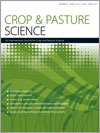Crop and Pasture Science
Volume 63
Numbers 11 & 12 2012
Much of Australia’s agricultural lands have subsoils with chemical and physical properties that restrict root growth and that are difficult to ameliorate; yield increases depends on genetic improvements in the tolerance of crops to these stresses. This paper describes an analysis of historical yield data of a set of wheat varieties characterised for their tolerance to a range of subsoil constraints to assess the regional importance of soil stresses. The work illustrated a method of using data from plant breeding trials to evaluate the importance of different plant characteristics to yield and adaptation.
Studying environmental influence on seed storage protein expression is useful in revealing the basic molecular mechanisms that are influenced by the environment and that affect productivity and quality. Analysing seed protein profiles of five narrow-leafed lupin cultivars grown under three different environmental conditions demonstrates that lupin seed protein expression is mostly genetically controlled with no significant influence of the environment. This result indicates the importance of breeding new lupin cultivars targeting specific proteins without being too concerned about environmental influences.
Soil cover and nutrient recycling depend on the dynamics of plant residue decomposition. We studied the effects of chemical composition on the decomposition rates of various cover crops and its benefits to a subsequent maize crop. Cover plants with the lowest lignin concentrations, and thus faster residue decomposition rates, contributed to higher maize yields.
Seed loss caused by pod-shatter during harvesting is one of the main problems in rapeseed production worldwide. It is difficult for breeders to test pod shatter resistance of rapeseed cultivars and we constructed a genetic map of Brassica napus and identified 13 QTLs for pod-shatter resistance. These results may serve as a valuable basis for further molecular dissection of pod-shatter resistance in B. napus and they may be useful for marker-assisted selection of pod-shatter resistant cultivars.
Adzuki bean serves as a source of primary nutrition to millions of people because of its high protein, vitamin and mineral content. Adzuki bean is susceptible to many pathogens including several viral, fungal and bacterial pathogens, and genetic transformation could be used to conquer the problems that traditional breeding methods cannot solve. The present study successfully improved virus resistance using genetic engineering in adzuki bean.
Faba bean, oats and Italian ryegrass are important in New Zealand as supplementary feed sources of cattle and sheep. During winter there was insufficient feed supply therefore, those forage crops could be grown effectively. However, crops growth depends on the rate of leaf appearance of each crop to intercept light and reach their canopy closure. Crops which produced faster leaf appearance could close their canopy quickly and produce higher yield. This would help the growers to plan and supply feed in greater volume throughout the year.
Intercropping maize (Zea mays) with perennial forage, such as palisade grass (Brachiaria brizantha) provides large amount of dry matter (DM) that can be used as straw for no-tillage system or as pasture for animal grazing. However, it is important to evaluate intercrops at different row spacing to avoid reductions in both maize grain and forage biomass production. The use of intercrop corn with palisade grass at 0.45 and 0.90 m rows spacing provides options for the production of forage DM without reducing maize grain yield.
Extensive use of single cytoplasm narrows the genetic diversity and increases crop’s vulnerability to pest and disease epidemics. To use alternate cytoplasms for forage sorghum hybrids, it is necessary to determine the effect of cytoplasm on yield and quality of the hybrids. The present study shows that the A3 cytoplasm based hybrids had fodder yield and quality comparable to A1 cytoplasm based hybrids, and hence A3 cytoplasm can be used along with A1 in the forage sorghum hybrid development program.
In Mediterranean environments, long-term global warming may cause intensification of summer conditions (higher temperatures and prolonged dry periods) causing threats to several crops. The chance to grow crops able to escape drought stress will be crucial for the agriculture in the near future. Mediterranean Dactylis show this ability through the summer dormancy; in this regard, one of the twelve studied genotypes seems to enclose high level of dormancy and yield.
Bituminaria bituminosa (L.) C.H. Stirton, commonly known as tedera, is a perennial legume of interest in Australia due to its tolerance of drought conditions and adaptation to low rainfall environments. Research near Bealiba, in Victoria’s low rainfall sheep zone, has found that tedera offers significant increases in dry matter production and forage nutritive value relative to existing forages, including lucerne. For sheep producers in low rainfall environments, this could potentially result in increased sheep stocking rates or greater liveweight gains, especially over the summer period.
Tropical grasses are being incorporated in temperate grasslands suffering flooding, as a result of less restrictive winters due to global warming. Tolerance to increasing flooding intensity of Chloris gayana and Panicum coloratum seedlings was assessed. Both species are tolerant to partial submergence, but when flood depth increases by fully submerging the seedlings, C. gayana is able to ‘escape’ from water while P. coloratum is not, thus strongly affecting its recovery. So, C. gayana appears as a more promising species for cultivation in grasslands subjected to flooding of unpredictable intensity.




